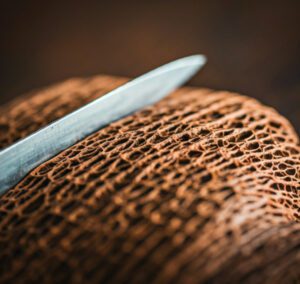The revolutionary material that’s reshaping the future of sustainable fashion while reducing environmental impact
What is Mycelium Leather?
Mycelium leather, also known as mushroom leather, is an innovative biomaterial grown from the root structure of mushrooms. This groundbreaking alternative to traditional leather represents a significant leap forward in sustainable fashion materials, offering a cruelty-free and environmentally friendly option for conscious consumers.
- Biodegradable within 90 days in proper conditions
- Requires minimal water usage compared to traditional leather
- Carbon-negative production process
- No animal products involved
The Science Behind Mushroom Leather
Mycelium leather is created through a fascinating biological process:
- Growth Phase: Mushroom spores are combined with organic agricultural waste in a controlled environment.
- Development: The mycelium network grows and interweaves, creating a dense mat of fibers.
- Harvesting: The material is harvested before mushroom caps form.
- Processing: The mycelium mat is treated and processed to achieve leather-like properties.
- Finishing: The material is dyed and finished using eco-friendly processes.
Environmental Impact Comparison
| Factor | Traditional Leather | Mycelium Leather |
|---|---|---|
| Water Usage | 2,000+ gallons per pound | Less than 100 gallons per pound |
| Production Time | Months to years | 2-3 weeks |
| Chemical Usage | Heavy use of toxic chemicals | Minimal, mostly natural processes |
| Land Use | Extensive grazing land required | Minimal vertical space needed |
Applications in Sustainable Fashion
Mycelium leather is revolutionizing various fashion categories:
- Luxury handbags and accessories
- Footwear and sneakers
- Clothing and outerwear
- Interior design and upholstery
- Automotive interiors
Leading Brands Embracing Mycelium
Major fashion houses and sustainable brands are increasingly incorporating mycelium leather into their collections, signaling a significant shift in the industry towards more sustainable materials.
Environmental Benefits
- Reduced Water Consumption: Uses up to 99% less water than traditional leather production
- Lower Carbon Footprint: Carbon-negative production process
- Zero Waste: Fully biodegradable and can be grown to size
- Agricultural Waste Reduction: Uses waste products as growing medium
- No Animal Impact: Completely cruelty-free production process
Challenges and Future Development
While mycelium leather shows incredible promise, some challenges remain:
- Scaling production to meet growing demand
- Optimizing durability for different applications
- Reducing production costs to increase accessibility
- Standardizing quality across different manufacturers
How to Support the Mycelium Revolution
- Look for products made with mycelium leather when shopping
- Support brands that are investing in sustainable materials
- Share information about mycelium leather with others
- Consider investing in companies developing sustainable materials
Conclusion
Mycelium leather represents a revolutionary step forward in sustainable fashion materials. Its minimal environmental impact, coupled with its versatility and growing adoption by major brands, positions it as a key player in the future of sustainable fashion. As technology advances and production scales up, we can expect to see this innovative material become increasingly prevalent in our everyday lives.
